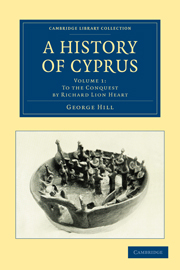Book contents
- Frontmatter
- Contents
- Preface
- List of Illustrations and Maps
- Lists of Books Consulted
- Chapter I The Land
- Chapter II The Stone Age
- Chapter III The Bronze Age
- Chapter IV The Religion of Early Cyprus
- Chapter V The Greek Colonization
- Chapter VI Phoenicians, Assyrians and Egyptians
- Chapter VII From Cyrus to Alexander
- Chapter VIII The Successors
- Chapter IX The Ptolemies
- Chapter X The Arts in Pre-Roman Cyprus
- Chapter XI The Roman Province
- Chapter XII Byzantium and Islam
- Addenda
- Index
- Plate section
Chapter XII - Byzantium and Islam
Published online by Cambridge University Press: 05 November 2011
- Frontmatter
- Contents
- Preface
- List of Illustrations and Maps
- Lists of Books Consulted
- Chapter I The Land
- Chapter II The Stone Age
- Chapter III The Bronze Age
- Chapter IV The Religion of Early Cyprus
- Chapter V The Greek Colonization
- Chapter VI Phoenicians, Assyrians and Egyptians
- Chapter VII From Cyrus to Alexander
- Chapter VIII The Successors
- Chapter IX The Ptolemies
- Chapter X The Arts in Pre-Roman Cyprus
- Chapter XI The Roman Province
- Chapter XII Byzantium and Islam
- Addenda
- Index
- Plate section
Summary
At the end of the fourth century, the province of Cyprus, as we have seen, was included in the Diocese of the Orient, under the Comes Orientis. This Diocese itself was grouped with four others—Thrace, Asiana, Pontus and Egypt—in the Prefecture of the Orient, under a Praetorian Prefect, on whose recommendation the provincial governor was appointed by the Emperor. The references to the history of Cyprus during the period with which this chapter is concerned are merely incidental to the history of the Empire as a whole, and throw very little light on any details of organization, civil or military, peculiar to the island. Like the rest of the provinces, it must have been bled by the Byzantine treasury, except when the power of extortion was transferred to the hands of the Arab invaders; and the unhappiness of the population under the imperial oppression made it the more willing to accept a change of masters.
We have but little information of the amount of the revenue, and that little is late. Thus it is said by some of the Oriental chroniclers that Muawiya, when he invaded Cyprus in the middle of the seventh century, laid on the island a perpetual tribute of 7000 or 7200 pieces of gold, and that it was equivalent to the tribute exacted at the time by the Greek Emperors. The sum seems ridiculously small, seeing that under the last Comneni the Emperor drew from it 700 pounds of gold a year, or 50,400 besants.
- Type
- Chapter
- Information
- A History of Cyprus , pp. 257 - 329Publisher: Cambridge University PressPrint publication year: 2010First published in: 1940

